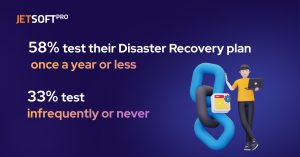The creation of a “technical debt” very often occurs in product development. This happens when a company strives to develop a product as quickly as possible, neglecting factors such as working out a sufficient budget, time frames, the skills of developers in the team, and constant changes to the Statement of Work (SOW). It would seem that there is nothing terrible here, you would think there are small defects. Usually, this debt continues to grow, and you gradually find yourself in a situation where it is almost impossible to get out of it. Namely, it may turn out that you simply do not have time to develop certain parts of the product. Alternatively, your code is of very low quality, which increases the application development time, and as a result, your development productivity drops to almost zero. And as a final point, the motivation of developers also falls, because no one likes to disassemble and rework low-quality work.
It’s crucial to balance creating good-quality code and making products quickly. It’s better not to ignore either aspect to avoid getting into technical debt. If you consistently opt for quick fixes instead of well-thought-out solutions, you may find yourself spending a lot of time fixing past mistakes. Following this approach will result in a situation where 90% of the development revolves around addressing issues caused by those quick fixes.
The code’s structure requires making smart decisions for the future. It also involves promptly fixing small problems that don’t affect the big picture. Team communication is key, with programmers explaining in detail to the senior specialist overseeing the architecture what they’re doing and why. This collaborative approach helps mitigate technical debt and ensures smoother software maintenance in the long run.
Checklist for Self-Assessment
We’ve crafted 20 questions for you to ask your team, helping you monitor the progress of your technical debt and ensure all processes run smoothly.
1. Are we regularly updating our software and hardware for the latest security patches?
Tip: To keep your computer systems safe, make it a habit to update both software and hardware regularly. Think of it like giving your devices a cool makeover every month! If there’s a super important security fix, don’t wait—apply it ASAP. And hey, run some checks regularly to stay on top of any potential weak spots.
2. How often do we review code to ensure it follows best practices and meets quality standards?
Tip: When doing a code review, it’s suggested that a software engineer focuses on the job they were given and doesn’t make unnecessary changes while writing the code. This way, they stay on track and don’t mess with parts of the code that weren’t supposed to be changed. Focus on no more than 500 lines during each review to make the process more careful and effective.
3. Have we recently tested our disaster recovery plan to ensure it works in emergencies?
Tip: There’s no specific perfect number of how much you should test your disaster plan per year, but the more you practice, the better prepared you’ll be in the end. It’s essential to recognize that you likely need to test your disaster recovery more frequently than you currently do.

4. Is our development environment separate from production to prevent issues?
Tip: Ensure a clear separation between development and production environments. Use separate servers or containers for testing and development to minimize the risk of unintended consequences in the live system. Consequently, this separation provides a controlled environment for testing and debugging without affecting the production environment.
5. What’s our average time to resolve critical technical problems, and how can we improve it?
Tip: Consider implementing a systematic approach to address critical technical problems promptly. Devote specific time blocks for issue resolution, prioritize high-impact problems, and explore automation tools to streamline the resolution process. By optimizing workflows, you can make better use of the 13.5 hours developers spend on technical debt each week.
6. Do we regularly update and maintain documentation for our systems and processes?
Tip: Establish a routine for regular documentation updates. Assign responsibility for documentation maintenance, schedule periodic reviews, and encourage collaboration among team members to keep information accurate and up-to-date. Utilize documentation tools and version control to track changes effectively.
7. How often do we back up our data, and have we tested the restoration process?
Tip: Implement a robust backup strategy by scheduling regular automated backups. Additionally, regularly test the restoration process to ensure data recoverability in case of emergencies. Document and update the backup procedures, involving relevant team members to guarantee a smooth recovery in critical situations.
8. Are there any outdated systems needing upgrading or replacing?
Tip: Conduct a comprehensive audit of existing systems to identify outdated technologies or software. Prioritize upgrading or replacing systems that pose security risks or hinder efficiency. Develop a roadmap for upgrades, and allocate resources and time for a phased transition to modern, sustainable solutions.
9. What steps do we take to monitor and enhance system performance?
Tip: Implement a robust system monitoring strategy using performance monitoring tools. Regularly analyze performance metrics, identify potential bottlenecks, and proactively address issues. Establish a continuous improvement process to enhance system performance based on monitoring insights, ensuring optimal functionality.
10. Do we handle technical debt during development, and how do we prioritize it?
Tip: Integrate technical debt management into the development process. Establish clear guidelines for identifying and addressing technical debt during sprints. Prioritize tasks based on impact and urgency, considering the long-term consequences. Regularly revisit and reassess priorities to maintain a balance between new feature development and technical debt management.
11. How often do we conduct security audits to identify and address vulnerabilities?
Tip: Regularly conduct security audits to identify and address vulnerabilities. Perform scheduled audits and engage external cybersecurity experts for comprehensive assessments. Furthermore, develop a response plan for identified vulnerabilities, including prioritization and swift resolution. Continuously update security protocols based on audit findings to enhance overall system resilience.
12. Do our development teams use a version control system for efficient code management?
Tip: Implement a version control system (e.g., Git) for efficient code management. Encourage consistent usage across development teams, emphasizing branching and merging strategies. Provide training to ensure team members are proficient in version control practices. Regularly review and update version control workflows to align with evolving project needs.
13. Do we understand the dependencies and third-party components in our systems?
Tip: Maintain a comprehensive understanding of dependencies and third-party components in your systems. Regularly audit and document dependencies, ensuring awareness of potential vulnerabilities. Subscribe to security alerts for third-party components and establish a process for prompt updates. This awareness minimizes security risks associated with outdated components.
14. Are team members provided ongoing training to stay current with tech trends?
Tip: Prioritize ongoing training to keep team members updated on emerging tech trends. Encourage participation in conferences, workshops, and online courses. Additionally, allocate time for knowledge-sharing sessions within the team. Foster a culture of continuous learning to ensure your team remains adaptive and well-equipped to embrace technological advancements.
15. How often do we update access controls to maintain proper permissions?
Tip: Regularly update access controls to align with changing roles and responsibilities. Conduct periodic access reviews and audits to ensure permissions are accurate and necessary. Implement a process for promptly revoking access for employees who no longer require it. This practice enhances security by limiting unauthorized access.
16. Is there a process for retiring old technologies and adopting newer solutions?
Tip: Establish a systematic process for retiring old technologies and adopting newer solutions. Regularly assess the relevance and efficiency of existing technologies. Moreover, develop migration plans for outdated systems, taking into account scalability and compatibility. Communicate changes transparently to stakeholders and provide adequate training for a smooth transition.
17. Do we have automated testing processes for continuous integration and deployment?
Tip: Implement automated testing processes for continuous integration and deployment (CI/CD). Utilize tools like Jenkins or GitLab CI to automate testing at every code change. Integrate automated testing into your development pipeline to identify and rectify issues early. This accelerates development cycles while maintaining code quality.
18. When did we last evaluate the scalability of our infrastructure for growth?
Tip: Regularly evaluate the scalability of your infrastructure to accommodate growth. Assess current usage patterns, anticipate future needs, and review infrastructure scalability. Furthermore, optimize resources to handle increased demand, and consider cloud solutions for enhanced flexibility. Periodically revisit scalability assessments to align with evolving business requirements.
19. How do we track and prioritize technical debt in projects?
Tip: Establish a systematic approach to track and prioritize technical debt in projects. Use tools like Jira or Trello to create a backlog specifically for technical debt. Additionally, prioritize tasks based on impact and urgency, ensuring that technical debt reduction remains an integral part of project planning and execution.
20. Have we assessed the impact of upcoming tech changes or industry shifts on our systems?
Tip: Regularly assess the impact of upcoming tech changes or industry shifts on your systems. Stay informed about industry trends, attend conferences, and engage in industry forums. Conduct periodic reviews to ensure that your systems remain adaptable to emerging technologies. Additionally, develop a roadmap for necessary adjustments to stay ahead of technological advancements.

